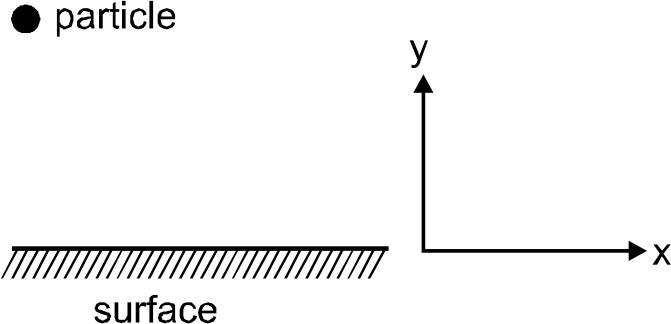A particle of mass m moving with a velocity (3ˆi+2ˆj)ms−1 collides with another body of mass M and finally moves with velocity (−2ˆi+ˆj)ms−1. Then during the collision
The correct Answer is:B, D
Impulse=Δp=m(vf−vi)
∴ Impulse received by m
=m[(−2ˆi+ˆj)−(3ˆi+2ˆj)]
=m(−5ˆi−ˆj)
Impulse received by M=-(impulse received by m)
=m(5ˆi+ˆj)
Topper's Solved these Questions
- BOOK - DC PANDEYCHAPTER - CENTRE OF MASS, LINEAR MOMENTUM AND COLLISIONEXERCISE - Level 2 Comprehension Based4videos
CENTRE OF MASS, LINEAR MOMENTUM AND COLLISION
- BOOK - DC PANDEYCHAPTER - CENTRE OF MASS, LINEAR MOMENTUM AND COLLISIONEXERCISE - Level 2 Comprehension Based Questions3videos
CENTRE OF MASS, LINEAR MOMENTUM AND COLLISION
- BOOK - DC PANDEYCHAPTER - CENTRE OF MASS, LINEAR MOMENTUM AND COLLISIONEXERCISE - Level 2 Single Correct Option1videos
CENTRE OF MASS, LINEAR MOMENTUM AND COLLISION
- BOOK - DC PANDEYCHAPTER - CENTRE OF MASS, IMPULSE AND MOMENTUMEXERCISE - Comprehension type questions15videos
CENTRE OF MASS, IMPULSE AND MOMENTUM
- BOOK - DC PANDEYCHAPTER - CIRCULAR MOTIONEXERCISE - Medical entrances s gallery19videos
CIRCULAR MOTION
Similar Questions
Particle A of mass m1 moving with velocity (√3ˆi+ˆj)ms−1 collides with another particle Bof mass m2 which is at rest initially. Let →V1and→V2 be the velocities of particles A and B after collision respectively. If m1=2m2 and after collision →V1−(ˆi+√3ˆj)ms−1, the angle between →V1and→V2 is :
View SolutionA particle of mass m moving with velocity 2v collides with another particle of mass 3m moving with velocity v in the same direction.If it is perfect inelastic collision,the loss of kinetic energy of the system is
View Solution
Knowledge Check
- Question 1 - Select One
A partical of mass 'm' moving with a velocity (3ˆi+2ˆj)m/s collides with statinary mass 'M' and finally 'm' moves with a velocity (−2ˆi+ˆj)m/s if mM=113 the velocity of the M after collision is?
A(5ˆi+ˆj)m/sB(5ˆi−ˆj)m/sC(5ˆi13−ˆj13)m/sD(5ˆi13+ˆj13)m/s - Question 2 - Select One
A body of mass 3 kg moving with a velocity (2ˆi+3ˆj+3ˆk) m/s collides with another body of mass 4 kg moving with a velocity (3ˆi+2ˆj−3ˆk) m/s. The two bodies stick together after collision. The velocity of the composite body is
A17(4ˆi+6ˆj−3ˆk)B17(18ˆi+17ˆj−3ˆk)C17(6ˆi+4ˆj−6ˆk)D17(9ˆi+8ˆj−6ˆk) - Question 3 - Select One or More
A body of mass m moving with a velocity v in the x direction collides with another body of mass M moving in y direction with a velocity V. They coalesce into one body during collision.
AThe magnitude of momentum of the composition body [(mv)2+(MV)2]1/2BThe fraction of initial K.E. transformed into heat is =(mMm+M)(v2+V2mv2+MV2)CDecrease in kinetic energy is mM2(m+M)(v2+V2)DNone of these
In a reference frame a man A is moving with velocity (3ˆi−4ˆj)ms−1 and another man B is moving with velocity (ˆi+ˆj)ms−1 relative to A. Find the actual velocity of B.
View SolutionA body A, oFIGURE m=0.1 kg has a initial velocity oFIGURE3ˆikms−1. It collides elastically with another body. B oFIGURE the same mass which has an initial velocity oFIGURE 5ˆjms−1. AFIGUREter collision, A moves with a velocity →v=4(ˆi+ˆj). The energy oFIGURE B aFIGUREter collision is written as x10J. The value oFIGURE x is _.
View SolutionA particle moving with velocity (2ˆi−3ˆj) m/s collides with a surface at rest in xz–plane as shown in figure and moves with velocity (2ˆi+2ˆj) m/s after collision. Then coefficient of restitution is :
 View Solution
View SolutionA particle moving with a velocity of (4ˆi−ˆj ) mis strikes a fixed smooth wall and finally moves with a velocity of (3ˆi+2ˆj) m/s. The coefficient of restitution between the wall and the particle in the collision will be
View SolutionA body of mass m moving with velocity 3km/h collides with a body of mass 2m at rest. Now, the coalesced mass starts to move with a velocity
View Solution
